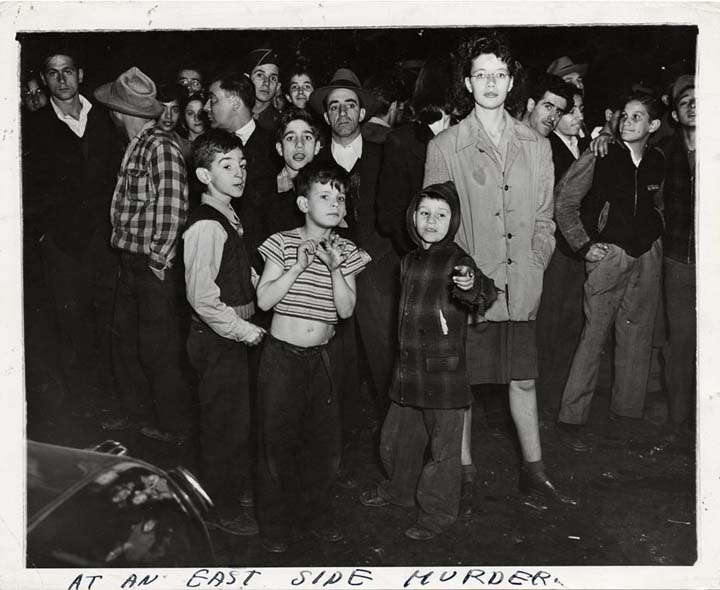Weegee's Tabloid City at ICP
In a single decade, starting in 1935, Arthur Fellig (1899-1968), the photographer who re-named himself "Weegee the Famous," changed the way New Yorkers viewed their city. The Austrian-born son of Jewish immigrants, who grew up poor on the Lower East Side, got a job as a darkroom technician in 1924 at Acme Newspictures (later UPI). After ten years, he left to become a freelance photographer.
From the outset, he chose to shoot the "naked city" at night. Flash photography was new; the landscape took on a completely different aspect in the dark; and that's when most of the city's notorious crime bosses set about their business. Weegee occupied a shabby little apartment near police HQ and installed a police-band radio. He rested fully clothed, his kit close at hand, ready to jump into his car and head to a crime scene; Weegee often arrived ahead of the law. One of the great delights of this show is the recreation of his room, complete with tabloid headlines pinned to the wall and cluttered with his camera gear, alarm clock, electric fan--even a can of bedbug spray.
Brian Wallis, the curator, organized the show as an intense exploration of the period in which Weegee created not only his career but also his legacy-and the context in which he made these unforgettable images. In several instances, the same grisley crime scene depicted by Weegee is also seen through the lens of a police photographer's camera. While Weegee was interested in shock and awe- and he uses a set of strategies, such as including stunned onlookers at the scene-the "official" police photographs are taken strictly to record the facts.

At an East Side Murder, 1943. (c) Weegee/International Center of Photography.
Voyeuristically delving into the underbelly of New York, Weegee uncovered the misfortunes of tenement dwellers caught in the blinding light of his flash. His photographs reveal the brutal realism of the world he chose to inhabit and celebrate in all of its carnivalesque variety. During this period, he kept the tabloids supplied with pictures that would wake up blue-collar workers on their early morning subway commutes. Mob figures, one of whom was found tied into a bundle and stuffed into a small trunk; fires; hideous car crashes and other disasters are what he sought out. But, Mr. Wallis said at the preview last week, sometimes the pictures were a little too gruesome for the newspapers. In that case, Weegee would simply airbrush out the offending imagery and resubmit the picture.
The exhibition includes a series of touch-screen monitors on which the substance of Weegee's world and his work are brilliantly contextualized. On one, you can read news articles about the murders that Weegee photographed and view the police photographs of the same situations. On another you can turn the pages of his first book, "Naked City" (1945), then compare the photographs in the book with their appearance in the tabloids.
Weegee also wrote extensively and organized his own exhibitions at the Photo League, the influential photographic organization that promoted socially concerned photographyn and focused primarily on celebrating the working classes. This visibility helped promote Weegee's growing reputation as a news photographer. The general acceptance of his dramatic photographic style, which did not shy away from lower-class subjects in dire straits, led to the acquisition of his work by the Museum of Modern Art and its inclusion in two group shows there, in 1943 and 1945.
"His best photographs combine wit, daring, and surprisingly original points of view, particularly when considered in light of contemporaneous press photos and documentary photography," said Mr. Wallis. "His Depression-era New York photographs need to be considered seriously alongside other key documentarians of the thirties, such as Dorothea Lange, Robert Capa, Walker Evans, and Berenice Abbott."
Weegee: Murder Is My Business continues at the International Center of Photography through September 2, 2012. 1133 Avenue of the Americas, NY, NY.
For a chapter-by-chapter presentation of Naked City, 125 prints of images from Weegee's first book are on view at Steven Kasher Gallery through February 25th. 521 West 23rd Street, NY, NY.
02012012


